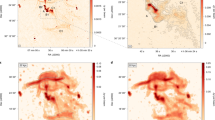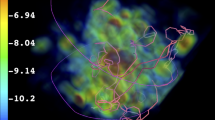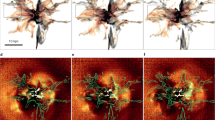Abstract
Clusters of galaxies are thought to contain about ten times as much dark matter as baryonic matter1. The dark component therefore dominates the gravitational potential of a cluster, and the baryons confined by this potential radiate X-rays with a luminosity that depends mainly on the gas density in the cluster's core2. Predictions of the X-rays' properties based on models of cluster formation do not, however, agree with the observations. If the models ignore the condensation of cooling gas into stars and feedback from the associated supernovae, they overestimate the X-ray luminosity because the density of the core gas is too high. An early episode of uniformly distributed supernova feedback could rectify this by heating the uncondensed gas and therefore making it harder to compress into the core3,4,5,6,7,8,9,10,11, but such a process seems to require an implausibly large number of supernovae6,8,12,13,14. Here we show how radiative cooling of intergalactic gas and subsequent supernova heating conspire to eliminate highly compressible low-entropy gas from the intracluster medium. This brings the core entropy and X-ray luminosities of clusters into agreement with the observations, in a way that depends little on the efficiency of supernova heating in the early Universe.
This is a preview of subscription content, access via your institution
Access options
Subscribe to this journal
Receive 51 print issues and online access
$199.00 per year
only $3.90 per issue
Buy this article
- Purchase on Springer Link
- Instant access to full article PDF
Prices may be subject to local taxes which are calculated during checkout


Similar content being viewed by others
References
Evrard, A. E. The intracluster gas fraction in X-ray clusters: constraints on the clustered mass density. Mont. Not. R. Astron. Soc. 292, 289–297 (1997).
Sarazin, C. L. X-ray Emissions from Clusters of Galaxies (Cambridge Univ. Press, Cambridge, 1988).
Evrard, A. E. & Henry, J. P. Expectations for X-ray cluster observations by the ROSAT satellite. Astrophys. J. 383, 95–103 (1991).
Kaiser, N. Evolution of clusters of galaxies. Astrophys. J. 383, 104–111 (1991).
Ponman, T. J., Cannon, D. B. & Navarro, J. F. The thermal imprint of galaxy formation on X-ray clusters. Nature 397, 135–137 (1999).
Balogh, M. L., Babul, A. & Patton, D. R. Pre-heated isentropic gas in groups of galaxies. Mon. Not. R. Astron. Soc. 307, 463–479 (1999).
Wu, K. K. S., Fabian, A. C. & Nulsen, P. E. J. The effect of supernova heating on cluster properties and constraints on galaxy formation models. Mon. Not. R. Astron. Soc. 301, L20–L24 (1998).
Wu, K. K. S., Fabian, A. C. & Nulsen, P. E. J. Non-gravitational heating in the hierarchical formation of X-ray clusters. Mon. Not. R. Astron. Soc. 318, 889–912 (2000).
Cavaliere, A., Menci, N. & Tozzi, P. Hot gas in clusters of galaxies: the punctuated equilibria model. Mon. Not. R. Astron. Soc. 308, 599–608 (1999).
Tozzi, P. & Norman, C. The evolution of X-ray clusters and the entropy of the intracluster medium. Astrophys. J. 546, 63–84 (2001).
Bialek, J. J., Evrard, A. E. & Mohr, J. J. Effects of preheating on X-ray scaling relations in galaxy clusters. Astrophys. J. 555, 597–612 (2001).
Bryan, G. L. Explaining the entropy excess in clusters and groups of galaxies without additional heating. Astrophys. J. 544, L1–L5 (2001).
Kravtsov, A. V. & Yepes, G. On the supernova heating of the intergalactic medium. Mon. Not. R. Astron. Soc. 318, 227–238 (2000).
Bower, R. et al. The impact of galaxy formation on the X-ray evolution of clusters. Mon. Not. R. Astron. Soc. 325, 497–508 (2001).
Navarro, J. F., Frenk, C. S. & White, S. D. M. A universal density profile from hierarchical clustering. Astrophys. J. 490, 493–508 (1997).
Frenk, C. S. et al. The Santa Barbara cluster comparison project: a comparison of cosmological hydrodynamics simulations. Astrophys. J. 525, 554–582 (1999).
Edge, A. C. & Stewart, G. C. EXOSAT observations of clusters of galaxies. I—The X-ray data. Mon. Not. R. Astron. Soc. 252, 414–427 (1991).
Markevitch, M. The L X-T relation and temperature function for nearby clusters revisited. Astrophys. J. 504, 27–34 (1998).
Arnaud, M. & Evrard, A. E. The L X-T relation and intracluster gas fractions of X-ray clusters. Mon. Not. R. Astron. Soc. 305, 631–640 (1999).
Pen, U. Heating of the intergalactic medium. Astrophys. J. 510, L1–L5 (1999).
Voit, G. M. & Bryan, G. L. On the distribution of X-ray surface brightness from diffuse gas. Astrophys. J. 551, L139–L142 (2001).
Bryan, G. L. & Voit, G. M. The X-ray surface brightness distribution from diffuse gas. Astrophys. J. 556, 590–600 (2001).
Wu, K. K. S., Fabian, A. C. & Nulsen, P. E. J. The soft X-ray background: evidence for widespread disruption of the gas halos of galaxy groups. Mon. Not. R. Astron. Soc. 324, 95–107 (2001).
Knight, P. A. & Ponman, T. J. The properties of the hot gas in galaxy groups and clusters from 1D hydrodynamical simulations—I. Cosmological infall models. Mon. Not. R. Astron. Soc. 289, 955–972 (1997).
Pearce, F. R., Thomas, P. A., Couchman, H. M. P. & Edge, A. C. The effect of radiative cooling on the X-ray properties of galaxy clusters. Mon. Not. R. Astron. Soc. 317, 1029–1049 (2000).
Muanwong, O., Thomas, P. A., Kay, S. T., Pearce, F. R. & Couchman, H. M. P. The effect of radiative cooling on scaling laws of clusters and groups. Astrophys. J. 552, L27–L30 (2001).
Fabian, A. C., Crawford, C. S., Edge, A. C. & Mushotsky, R. F. Cooling flows and the X-ray luminosity-temperature relation for clusters. Mon. Not. R. Astron. Soc. 267, 779–784 (1994).
Balogh, M., Pearce, F. R., Bower, R. G. & Kay, S. T. Revisiting the cosmic cooling crisis. Mon. Not. R. Astron. Soc. 326, 1228–1234 (2001).
Eke, V., Navarro, J. F. & Steinmetz, M. The power spectrum dependence of dark matter halo concentrations. Astrophys. J. 554, 114–125 (2001).
Helsdon, S. F. & Ponman, T. J. The intragroup medium in loose groups of galaxies. Mon. Not. R. Astron. Soc. 315, 356–370 (2000).
Acknowledgements
We thank R. Bower and M. Balogh for discussions. G.M.V. receives partial support from NASA, and G.L.B. is supported by NASA through a Hubble fellowship.
Author information
Authors and Affiliations
Corresponding author
Rights and permissions
About this article
Cite this article
Voit, G., Bryan, G. Regulation of the X-ray luminosity of clusters of galaxies by cooling and supernova feedback. Nature 414, 425–427 (2001). https://doi.org/10.1038/35106523
Received:
Accepted:
Issue Date:
DOI: https://doi.org/10.1038/35106523
This article is cited by
-
Regulation of star formation in giant galaxies by precipitation, feedback and conduction
Nature (2015)
-
Large-Scale Structure Formation: From the First Non-linear Objects to Massive Galaxy Clusters
Space Science Reviews (2015)
-
The Chandra X-ray galaxy clusters at z<1.4: constraints on the evolution of L X −T−M g relations
Astrophysics and Space Science (2014)
-
Active Galactic Nuclei Feedback and Clusters
Journal of Astrophysics and Astronomy (2011)
-
Thermodynamical Properties of the ICM from Hydrodynamical Simulations
Space Science Reviews (2008)
Comments
By submitting a comment you agree to abide by our Terms and Community Guidelines. If you find something abusive or that does not comply with our terms or guidelines please flag it as inappropriate.



